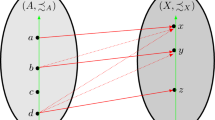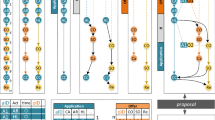Abstract
Behavioral profiles have been proposed as a behavioral abstraction of dynamic systems, specifically in the context of business process modeling. A behavioral profile can be seen as a complete graph over a set of task labels, where each edge is annotated with one relation from a given set of binary behavioral relations. Since their introduction, behavioral profiles were argued to provide a convenient way for comparing pairs of process models with respect to their behavior or computing behavioral similarity between process models. Still, as of today, there is little understanding of the expressive power of behavioral profiles. Via counter-examples, several authors have shown that behavioral profiles over various sets of behavioral relations cannot distinguish certain systems up to trace equivalence, even for restricted classes of systems represented as safe workflow nets. This paper studies the expressive power of behavioral profiles from two angles. Firstly, the paper investigates the expressive power of behavioral profiles and systems captured as acyclic workflow nets. It is shown that for unlabeled acyclic workflow net systems, behavioral profiles over a simple set of behavioral relations are expressive up to configuration equivalence. When systems are labeled, this result does not hold for any of several previously proposed sets of behavioral relations. Secondly, the paper compares the expressive power of behavioral profiles and regular languages. It is shown that for any set of behavioral relations, behavioral profiles are strictly less expressive than regular languages, entailing that behavioral profiles cannot be used to decide trace equivalence of finite automata and thus Petri nets.
Similar content being viewed by others
References
Armas-Cervantes, A., Baldan, P., Dumas, M., García-Bañuelos, L.: Behavioral comparison of process models based on canonically reduced event structures. In: Business Process Management—12th International Conference, BPM 2014, Haifa, Israel, Sep 7–11, 2014. Proceedings, vol. 8659 of Lecture Notes in Computer Science, pp. 267–282. Springer, Berlin (2014)
Armas-Cervantes, A., Baldan, P., García-Bañuelos, L.: Reduction of event structures under history preserving bisimulation. J. Logic. Algebraic Methods Program. (2015) (in press)
Armas-Cervantes, A., Dumas, M., García-Bañuelos, L., Polyvyanyy, A.: On the suitability of generalized behavioral profiles for process model comparison. In: Web Services and Formal Methods 11th International Workshop, WS-FM 2014, Eindhoven, The Netherlands, Sep 11–12 Proceedings (Accepted on 10 July 2014) (2014)
Boudol, G.: Flow event structures and flow nets. In: Semantics of Systems of Concurrent Processes, LITP Spring School on Theoretical Computer Science, La Roche Posay, France, April 23–27, 1990, Proceedings, vol. 469 of Lecture Notes in Computer Science, pp. 62–95. Springer, Berlin (1990)
Engelfriet, J.: Determinacy \({\longrightarrow}\) (observation equivalence = trace equivalence). Theor. Comput. Sci. (TCS), 36, 21–25 (1985)
Engelfriet J.: Branching processes of Petri nets. Acta Inf. 28(6), 575–591 (1991)
Haar S., Kern C., Schwoon S.: Computing the reveals relation in occurrence nets. Theor. Comput. Sci. (TCS) 493, 66–79 (2013)
Kunze, M., Weidlich, M., Weske, M.: Behavioral similarity: a proper metric. In: Business Process Management—9th International Conference, BPM 2011, Clermont-Ferrand, France, August 30–September 2, 2011. Proceedings, vol. 6896 of Lecture Notes in Computer Science, pp. 166–181. Springer, Berlin (2011)
Murata, T.: Petri nets: Properties, analysis and applications. Proc. IEEE 77(4) (1989)
Nielsen M., Plotkin G.D., Winskel G.: Petri nets, event structures and domains, Part I. Theor. Comput. Sci. (TCS) 13, 85–108 (1981)
Polyvyanyy, A., Weidlich, M., Conforti, R., La Rosa, M., ter Hofstede, A.H.M.: The 4C spectrum of fundamental behavioral relations for concurrent systems. In: Application and Theory of Petri Nets and Concurrency—35th International Conference, PETRI NETS 2014, Tunis, Tunisia, June 23–27, 2014. Proceedings, vol. 8489 of Lecture Notes in Computer Science, pp. 210–232. Springer, New York (2014)
Polyvyanyy, A., Weidlich, M., Weske, M.: Isotactics as a foundation for alignment and abstraction of behavioral models. In: Business Process Management—10th International Conference, BPM 2012, Tallinn, Estonia, Sep 3–6, 2012. Proceedings, vol. 7481 of Lecture Notes in Computer Science, pp. 335–351. Springer, New York (2012)
Sipser, M.: Introduction to the Theory of Computation, 3rd edn. Cengage Learning (2012)
van der Aalst, W.M.P.: Verification of workflow nets. In: Application and Theory of Petri Nets 1997, 18th International Conference, ICATPN ’97, Toulouse, France, June 23–27, 1997, Proceedings, vol. 1248 of Lecture Notes in Computer Science, pp. 407–426. Springer, Berlin (1997)
van der Aalst, W.M.P.: Workflow verification: finding control-flow errors using Petri-net-based techniques. In: Business Process Management, Models, Techniques, and Empirical Studies, vol. 1806 of Lecture Notes in Computer Science, pp. 161–183. Springer, New York (2000)
van Glabbeek, R.J.: The Linear Time-Branching Time Spectrum, vol. 458 of Lecture Notes in Computer Science. Springer, New York (1990)
van Glabbeek, R.J., Goltz, U.: Equivalence notions for concurrent systems and refinement of actions. In: Mathematical Foundations of Computer Science 1989, MFCS’89, Porabka-Kozubnik, Poland, August 28–Sept 1, 1989, Proceedings, vol. 379 of Lecture Notes in Computer Science, pp. 237–248. Springer, New York (1989)
van Glabbeek, R.J., Goltz, U.: Refinement of actions and equivalence notions for concurrent systems. Acta Informatica (ACTA) 37(4/5), 229–327 (2001)
Valk R., Vidal-Naquet G.: Petri nets and regular languages. J. Comput. Syst. Sci. (JCSS) 23(3), 299–325 (1981)
Weidlich M., Mendling J., Weske M.: Efficient consistency measurement based on behavioral profiles of process models. IEEE Trans. Softw. Eng. (TSE) 37(3), 410–429 (2011)
Weidlich, M., Mendling, J., Weske, M.: A foundational approach for managing process variability. In: Advanced Information Systems Engineering—23rd International Conference, CAiSE 2011, London, UK, June 20–24, 2011. Proceedings, vol. 6741 of Lecture Notes in Computer Science, pp. 267–282. Springer, New York (2011)
Weidlich M., Polyvyanyy A., Desai N., Mendling J., Weske M.: Process compliance analysis based on behavioural profiles. Inform. Syst. (IS) 36(7), 1009–1025 (2011)
Weidlich, M., Polyvyanyy, A., Desai, N., Mendling, J.: Process compliance measurement based on behavioural profiles. In: Advanced Information Systems Engineering, 22nd International Conference, CAiSE 2010, Hammamet, Tunisia, 2010. Proceedings, vol. 6051 of Lecture Notes in Computer Science, pp. 499–514. Springer, Berlin (2010)
Weidlich, M., Polyvyanyy, A., Mendling, J., Weske, M.: Efficient computation of causal behavioural profiles using structural decomposition. In: Applications and Theory of Petri Nets, 31st International Conference, PETRI NETS 2010, Braga, Portugal, June 21–25, 2010. Proceedings, vol. 6128 of Lecture Notes in Computer Science, pp. 63–83. Springer, New York (2010)
Weidlich, M., Polyvyanyy, A., Mendling, J., Weske, M.: Causal behavioural profiles—efficient computation, applications, and evaluation. Fundamenta Informaticae (FUIN) 113(3–4), 399–435 (2011)
Weidlich, M., Martijn, J., van der Werf, E.M.: On profiles and footprints-relational semantics for Petri nets. In: Application and Theory of Petri Nets—33rd International Conference, PETRI NETS 2012, Hamburg, Germany, June 25–29, 2012. Proceedings, vol. 7347 of Lecture Notes in Computer Science, pp. 148–167. Springer, Berlin (2012)
Yu, S.: Regular languages. In: Rozenberg, G., Salomaa, A. (eds.) Handbook of Formal Languages, pp. 41–110. Springer, Berlin Heidelberg (1997)
Author information
Authors and Affiliations
Corresponding author
Additional information
Thomas Hildebrandt, Joachim Parrow, Matthias Weidlich, and Marco Carbone
Since 2016, Abel Armas-Cervantes is with Queensland University of Technology
Rights and permissions
About this article
Cite this article
Polyvyanyy, A., Armas-Cervantes, A., Dumas, M. et al. On the expressive power of behavioral profiles. Form Asp Comp 28, 597–613 (2016). https://doi.org/10.1007/s00165-016-0372-4
Received:
Accepted:
Published:
Issue Date:
DOI: https://doi.org/10.1007/s00165-016-0372-4




